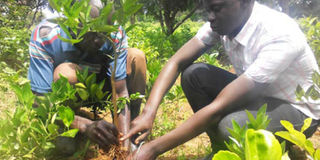Prime
A-Z of modern citrus production to master

Farmers examine an orange plant before planting. Seed selection is crucial to having good fruits. File photo
Fruit production is as old as mankind. In fact, the Bible reveals how the first human beings, Adam and Eve, tried to manage the ‘Garden of Eden’.
There is great hope that Uganda can become one of the best citrus producing nations but, as would rightly be expected, many farmers’ spirited efforts have been bogged down by pests and diseases, especially, in northern Uganda.
Ngetta Zonal Agricultural Research and Development Institute (Ngetta ZARDI) crop experts Bushira Apelle and Alfred Kumakech say that not all hope is lost, citrus production can boom again if, and only if, the proper procedures are followed to the dot.
Ideal conditions
Oranges are best suited for sandy soil and semi-arid areas that receive about 500mm of rainfall annually. This implies that citrus can be grown in most parts of Uganda, especially in the northern areas. According to Apelle, even in areas where the conditions are not favourable, farmers can improvise.
“Farmers can dig holes with about two feet radius and then put two basins of sand which works so well for the desired aeration,” Apelle says.
Planting
The best way to grow a healthy tree is to purchase a young tree or seedling. It is possible to plant seeds but according to Apelle, such trees are more vulnerable to disease. A young tree purchased from the nursery is actually a combination of two plants: one tree bred for healthy roots and other attributes, plus branches of another tree grafted onto the first.
Apelle reveals that the cardinal sin farmers make is improper planting that breeds the other imperfections. He advises farmers to consider budding at 30cm above level to avoid infections when it rains.
“Farmers shouldn’t plant with pot or the ‘ball’ soil around the seedling. They shouldn’t also plant too deep,” Apelle recommends.
The crop expert adds that farmers should be keen on site selection by looking for deep fertile soils to allow good surface and internal drainage. This allows deep root penetration and good anchorage of trees.
The soils should have PH range of 6-8. Excessively salty soils should be avoided as well as stony areas that interfere with rapid root development. Avoid planting citrus under big trees as citrus requires full sunlight for optimum growth and production.
Spacing
The recommended spacing measurement is 6m by 6m which translates to 111 trees per acre. For the 6m by 5m spacing one can get a plant population of 130.
Planting should be two feet deep and two feet wide. A farmer, according to Apelle, should dig a hole separating top soil from sub soil and start filling back topsoil mixed with compost manure.
“Plant the tree making sure that root collar is in line with the ground level. Cover the root ball with 0.5 to one inch of soil to seal the growing medium from direct contact with the air and reduce evaporation.”
The experts recommend inter-cropping to avoid soil erosion and in absence of rainfall, the young plants require thorough watering two to three weeks in the first week. Good weeding, mulching to contain weed and soil erosion is also required.
Orchard management
Apelles offers two options to farmers in managing the water distribution; using the structural (digging holes) method that originated from Kenya or mulching the trees. Where organic mulches are used, keep at least 12 inches of bare ground between the tree trunk and the mulches. It is advisable not to use fertilisers until the tree begins the new growth after planting.
Phosphate fertiliser is important for newly planted orange trees. Scatter fertilisers on the ground at least a foot from the tree trunk and water thoroughly. Farmers ought to use nitrogenous fertilisers like Urea and NPK. Citrus trees use large amounts of iron, zinc and manganese and you must supplement these for the best fruit yields.
They advise that fertilisers can be applied three times per year to the top 1 inch of soil around the tree’s root system.
Compost manure can take the place of chemical and liquid fertilisers for organic farmers. However, care must be taken because compost manure is high in salts, which can burn a tree’s root system. Chicken manure is not advisable as it has the highest salt content.
Challenges
The deadliest pests that attack citrus are the fruit flies and orange dog, according to Apelle. Ngetta ZARDI experts have devised a controlling measure, the pheromone trap.
In this control measure, a tablet is placed in a container to attract the flies.
The trap works like dog mating scent to lure a male for sex. When an insect moves closer, it is trapped by the sticky component. The death of male brings down the flies population.
Right
Urban farming is a response to a variety of pressures. Large parts of the developing world are facing shortages of water and arable land.
Governments and other sponsors have supported urban food-growing projects in Cuba, Colombia, Botswana and Egypt. In the developed world, small-scale urban farms are seen as an antidote to industrialised agriculture’s excesses, including chemical fertilisers that pollute. waterways and the high costs of transporting food to urban markets.
Source: FAO




